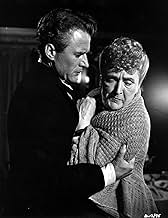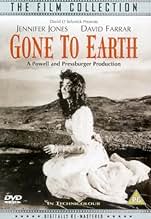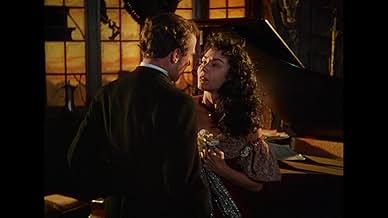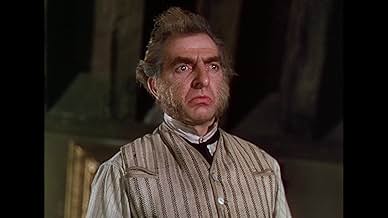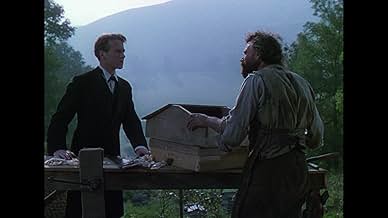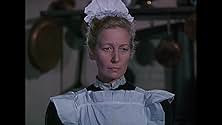VALUTAZIONE IMDb
6,9/10
1653
LA TUA VALUTAZIONE
Aggiungi una trama nella tua linguaA beautiful, superstitious, animal-loving Gypsy is hotly desired by a fox-hunting squire even after she marries a clergyman.A beautiful, superstitious, animal-loving Gypsy is hotly desired by a fox-hunting squire even after she marries a clergyman.A beautiful, superstitious, animal-loving Gypsy is hotly desired by a fox-hunting squire even after she marries a clergyman.
- Regia
- Sceneggiatura
- Star
- Premi
- 3 vittorie e 1 candidatura in totale
Arthur Mainzer
- Chapel elder
- (as Arthur Reynolds)
Recensioni in evidenza
An unlikely co-production between the British Archers production company, comprising Michael Powell and Emeric Pressburger and dictatorial Hollywood mogul David O Selznick, unsurprisingly starring the latter's wife Jennifer Jones, "Gone To Earth" is a visually remarkable and emotionally turbulent feature. Set in the rugged Shropshire countryside, the action centres around Jones' child of nature Hazel Woodus, only daughter of a semi-idiotic harpist father. Uneducated and wilful, Hazel is a dark haired beauty of wild, gypsy appearance and along with her unusual, instinctive relationship with animals, in particular, a stray fox she has adopted, is obviously set quite apart from the rest of the God-fearing village community where she and father eke out an existence.
Unwittingly causing havoc in the hearts and I dare say loins of almost every young man she meets, the womenfolk in the neighbourhood have Hazel marked down as a man-baiting temptress. Cast out into the street late at night by the Bible-punching mother of another potential suitor, she falls into the path of the brutish and headstrong local squire, David Farrar, who puts her up at his estate for the night, much to the morally-offended chagrin of his attitudinal man-servant Hugh Griffiths.
Later, at a local fair where Hazel sings accompaniment to her father's playing, she comes into the orbit of the new young pastor, Cyril Cusack, who almost immediately falls for her and proposes marriage, which she's bound to accept. However, Hazel has got into the blood of the caddish squire and a tug-of-love ensues over her which in the end, nobody wins.
I sometimes think these wonderful Archers films should come with a warning, "Abandon reality, all who enter here" as the viewer is transported into a stylised version of the everyday world peopled with highly individual, almost preternatural characters. The Thomas Hardy-esque story abounds with hunting and biblical allegories with Hazel identified both as the elusive fox no huntsman can capture let alone tame and also as an unwitting Eve-like stirrer of passions.
Of course it ends in tragedy but not before the Archers customary blend of sweeping narrative, atmospheric music and stunning colour cinematography has created another notable film almost impossible to categorise. Jones speaks a kind of pidgin-English as she immerses herself in her character, although she's probably most effective when not speaking. She doesn't have to, her dark sexuality and wild strangeness bring the menfolk to their knees anyway. Cusack and Farrar make excellent rivals for her in their different ways, the twin benevolent and malevolent influences on either shoulder of Hazel, speaking in her ear.
I'm no fan of hunting and am fully in favour of the fox-hunting ban in this country but I must admit I was carried along in the chase for Hazel's hand in another brilliant Archers production. As a postscript, singer Kate Bush, who in her youth bore a striking resemblance to Jones' appearance in this film, took inspiration from it for her "Hounds of Love" song.
Unwittingly causing havoc in the hearts and I dare say loins of almost every young man she meets, the womenfolk in the neighbourhood have Hazel marked down as a man-baiting temptress. Cast out into the street late at night by the Bible-punching mother of another potential suitor, she falls into the path of the brutish and headstrong local squire, David Farrar, who puts her up at his estate for the night, much to the morally-offended chagrin of his attitudinal man-servant Hugh Griffiths.
Later, at a local fair where Hazel sings accompaniment to her father's playing, she comes into the orbit of the new young pastor, Cyril Cusack, who almost immediately falls for her and proposes marriage, which she's bound to accept. However, Hazel has got into the blood of the caddish squire and a tug-of-love ensues over her which in the end, nobody wins.
I sometimes think these wonderful Archers films should come with a warning, "Abandon reality, all who enter here" as the viewer is transported into a stylised version of the everyday world peopled with highly individual, almost preternatural characters. The Thomas Hardy-esque story abounds with hunting and biblical allegories with Hazel identified both as the elusive fox no huntsman can capture let alone tame and also as an unwitting Eve-like stirrer of passions.
Of course it ends in tragedy but not before the Archers customary blend of sweeping narrative, atmospheric music and stunning colour cinematography has created another notable film almost impossible to categorise. Jones speaks a kind of pidgin-English as she immerses herself in her character, although she's probably most effective when not speaking. She doesn't have to, her dark sexuality and wild strangeness bring the menfolk to their knees anyway. Cusack and Farrar make excellent rivals for her in their different ways, the twin benevolent and malevolent influences on either shoulder of Hazel, speaking in her ear.
I'm no fan of hunting and am fully in favour of the fox-hunting ban in this country but I must admit I was carried along in the chase for Hazel's hand in another brilliant Archers production. As a postscript, singer Kate Bush, who in her youth bore a striking resemblance to Jones' appearance in this film, took inspiration from it for her "Hounds of Love" song.
I believe I saw this movie perhaps 50 plus years ago, as a young man. It must have been in the mid 1950s or around then. I found Jennifer Jones to be a marvelous actress in this movie and found that to be true in other movies she starred in. But I was overwhelmingly struck with the beauty of the Shrophire countryside which to some extent was almost as much of an attraction to me as Jennifer Jones. I have searched for a long time for this movie...but all I could truly remember of it , with the obvious exception of Miss Jones, was the scream or shout at the end of it ----Gone to Earth. I only know have found out what the meaning of that call was. I will be wanting to purchase this movie soon. Don Berghuis
Among the strangest, and loveliest, of the Archers films. As with so many of their films, its real subject is the profound, almost mystical, connection of people to their physical environment, most notably the British countryside. The much under-rated Jennifer Jones gives an utterly fearless performance, throwing herself into a role that sounds unplayable on paper. The Christopher Challis three-strip Technicolor photography is bold and gorgeous, underlining the central importance of the landscape. Strange in the best possible sense, in that it takes us somewhere we've never really been. Even the Bronte sisters couldn't capture rustic England as well. But they never had the benefit of Technicolor.
I heartily recommend this film, but as others have said before me, avoid the dreadfully hacked version- The Wild Heart. It amazes me that Selznick could ruin such a wonderful piece of cinema. For me the locations are stunningly beautiful yet bleak. Based on the Mary Webb novel the movie was filmed in Shropshire , the book , as most of Webb's were, was also set there. The windswept Stiperstones and The Devil's Chair are not make believe. They really do exist and you can easily visit these locations.I always wanted to visit Shropshire, as a child I loved the Lone Pine stories by Malcolm Saville that were set there ( I still do ). They, as Webb's stories all were set in real places. The little church ( Godshill ) in the film is still standing and you can still make out the shape of the baptism pool in the garden. It's a beautiful, atmospheric place.I have now visited these locations several times. The long chimney you see standing in several sequences can still be found in the ruins of the old Snailbeach mines. It is so wonderful to stand in these places, on these hills ( the stiperstones, the Long Mynd ) and imagine 57 years ago when all the actors and crew stood in the very same place, you can't explain how you feel, but it's something very extraordinary.The film itself is a strangely evocative piece that features eerily scored music, wild but effective performances. Cyril Cusack stands out in a restrained, dignified part as the sad parson.It is his character that I felt so sorry for.Although poor Jennifer Jones ( Hazel ) is a tormented soul that you can't help but feel attracted to.A glorious piece of cinema of the past with wonderful locations. The plot may be all too familiar but the scenery, the characters and yes, Foxy all help pass the time in a blink of an eye. Watch it a couple of times, each viewing brings out something else that you may have missed.
A beautifully made and gently rolling film, almost surreal in content.
Some moments almost seem off cue and through a breathtakingly simple narrative visual style, comes a story of innocence, passion and ultimate tragedy. The music is hypnotic and compliments the flow of the film.
Superb performance by all - including 'Foxy'! If this film was made today it would be showered with Oscars.
Finally, it is hard to see a comparable style in the British film industry prior to this and certainly nothing after it. It is this fact that I believe contributes to the films unique qualities.
Some moments almost seem off cue and through a breathtakingly simple narrative visual style, comes a story of innocence, passion and ultimate tragedy. The music is hypnotic and compliments the flow of the film.
Superb performance by all - including 'Foxy'! If this film was made today it would be showered with Oscars.
Finally, it is hard to see a comparable style in the British film industry prior to this and certainly nothing after it. It is this fact that I believe contributes to the films unique qualities.
Lo sapevi?
- QuizThe choir was the real choir from the local Methodist chapel. When he heard them singing, director Michael Powell said they were too good and he wanted them to sound "more ragged, like a choir of country folk" only to be told "But we ARE country folk, Mr. Powell."
- BlooperAs Abel and Hazel Woodus come down the hill to the chapel, the mine engine house disappears and then reappears between shots
- Citazioni
Hazel Woodus: The world wasn't made in seven days only for Abel Woodus.
- Versioni alternativeThe reedited and shortened version titled "The Wild Heart" was produced after a disagreement and court case between director Michael Powell and producer David O. Selznick. Selznick's changes are mainly:- (1) Adding a prologue. (2) Adding scenes explaining things, often by putting labels or inscriptions on them. (3) Adding more close-ups of Jennifer Jones (Selznick's wife). He also deleted a few scenes that he felt weren't dramatic enough. Sadly some of these were major plot points so the story doesn't make as much sense as the original. In his autobiographies, Powell claimed that Selznick only left about 35 mins of the original film. In fact there's a lot more than that. About 2/3 of the original remains.
- ConnessioniFeatured in The Late Show: Michael Powell (1992)
I più visti
Accedi per valutare e creare un elenco di titoli salvati per ottenere consigli personalizzati
- How long is Gone to Earth?Powered by Alexa
Dettagli
- Data di uscita
- Paesi di origine
- Lingua
- Celebre anche come
- Cuore selvaggio
- Luoghi delle riprese
- Aziende produttrici
- Vedi altri crediti dell’azienda su IMDbPro
- Tempo di esecuzione1 ora 50 minuti
- Proporzioni
- 1.37 : 1
Contribuisci a questa pagina
Suggerisci una modifica o aggiungi i contenuti mancanti

